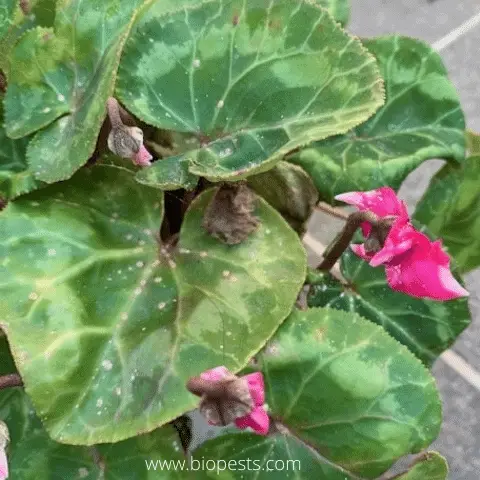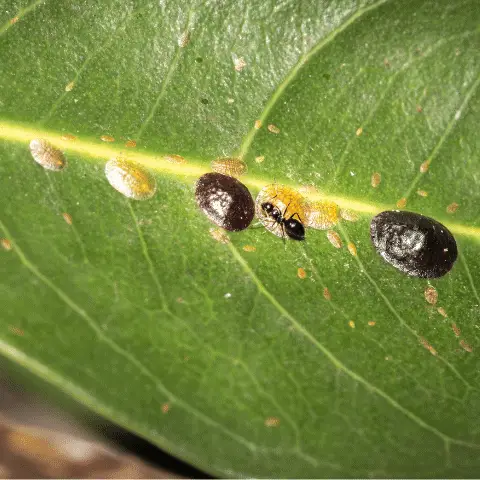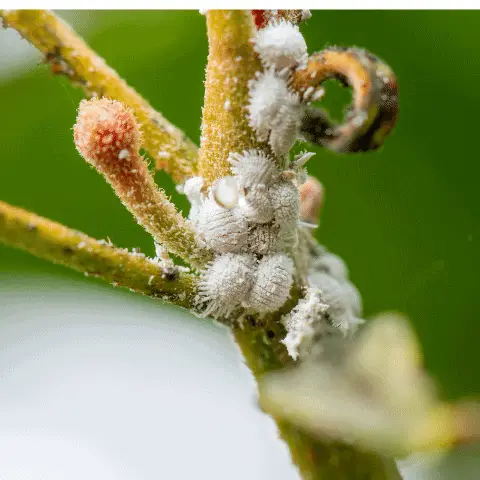If nature has taught us one lesson, it is that it’s better to work with her than against her. When we cooperate, nature helps us solve the problem. If we observe nature closely and start understanding how she operates, we will find the answers.
Pests and their natural enemies co-exist as balanced populations in an ideal well-managed organic environment.
Unfortunately, most of our homes are not such a paradise, and the pest population can explode, damage, and even destroy our house plants – if our intervention doesn’t take place.
This doesn’t mean that we should not take our lead from nature by utilizing as many of her tricks to control the pest as best we can. Organic and natural interventions are very effective.
Scale insects literally suck the life force out of your houseplants. As nearly 8000 different scale insects exist worldwide, one can imagine that few plants are immune against an infestation. We consider environmental factors as well as good practices to prevent scale infestation and proliferation.

The above picture shows a deformed cyclamen plant, infested with scale.
Scale insects have a natural ability to survive. All types are challenging to control sedentary creatures. A meaningful organic pest control protocol entails preventive and curative activities. It is not complicated but depending on local climate conditions should be followed routinely.
The majority of scale are difficult to control because of a clever shielding mechanism. The visible scale is not part of the living insect itself. It’s a protective covering secreted by the feeding insect in the form of a waxy shell, filament threads, or fuzz. Likewise, the eggs produced by the most common species of scale found on houseplants are protected by females’ cover.
How Scale Insects Become A Problem
Scale insects can be roughly divided into three distinct families: hard scale, soft scale, and mealybugs.

You’re most likely to notice female adult scale insects. They are most likely to attach themselves to the underside of leaves and build up in densely leafed areas, on stems and twigs, and other hidden positions. Noticing them in time is key for plant survival.
Males are rarely seen flying insects that don’t always feed, while the minute nymphs or crawlers are causing the spread. Preventing these crawlers from colonizing other areas is essential. One female scale can lay between 50 and 600 eggs in her lifetime.
Ants and whitefly are attracted by the sticky sweet honeydew many scale insects produce. An unsightly sooty mold develops on the honeydew.
It now becomes clear why monitoring houseplants for scale infestation is essential. Not only are the adults well protected, but the new generation is also a mobile mass near invisible to the eye. If the reproductive cycle continues unchecked, scale insects can destroy a favorite plant in a short period.
Tactics to prevent scale on houseplants can be divided into two main activities, preventative and curative.
Preventative tactics
1. Isolate and monitor new houseplants
Scale is often introduced by bringing a new plant home, one that is infected without it being immediately apparent. An effective way of preventing spread is to isolate any new plants for the house for one to three weeks – the reproductive cycle.
Even if one carefully inspects the plant, there is a chance that little crawlers or nymphs, which can be invisible to the naked eye, are already clinging to the underside of the leaves and against stems.
Similarly, if any plant in your home is Infected, move it as far away from other plants. Scale infestations have a way of attracting other pests, which then exacerbates the problem for all plants. Try to thoroughly clean and even disinfect any areas around infected plants.
2. Manually Inspect All Houseplants Often
Visually scrutinizing every plant at regular intervals should be a matter of routine, mainly if scale was picked up in the past. It will just provide that peace of mind that all is in order. Turning leaves over, inspecting stems and areas with dense growth can happen simultaneously with other routine activities – no need to spend extra time.

It is the fastest way to pick up scale before any significant damage to the plant results. Treating a few insects is, of course, also more manageable than fighting an infestation.
3. Spray Insecticidal Soap preventatively.
Many environmentally conscious plant lovers use an insecticidal spray to control plant pests as the first line of defense. It’s also great to use on plants as a ‘just in case’ preventative application. Use it to remove any possible or suspected pests. This spray is only active while wet and destroys insects on direct contact, including near-invisible scale crawlers. When it’s dried off the plant, the efficacy is gone. It’s gentle and by using natural soap, an organic way to help build plant vitality.
It may sound impractical to spray a plant with no apparent signs of any sort of infestation, but it can save a lot of hard work later.
A situation that may warrant a precautionary spay could look like this: When you return from a lengthy holiday or business trip to a house that’s been closed, therefore had minimal airflow or ventilation. A variety of bugs, including scale, could find a foothold on slightly stressed plants.
A further example: Living in an area of the country with high humidity? Or have you dealt with scale infestation in the past and just want to ensure all is going well? Give your plants a good covering every three to four weeks, focusing on areas where they would not be visible by a superficial glance.
Commercial varieties of insecticidal soap are available. Always check the label for non-organic additives. Nothing is easier than mixing up your own organic insecticidal soap: Here’s how:
- Mix one tablespoon of bleach-free pure soap with 1 quart of water in a spray bottle.
- Or 4 – 5 tablespoons of soap per gallon of water.
- Shake it up and coat plants well with the mixture.
- Use immediately.
- Discard any leftover liquid.
Do not add more soap. Spray out of direct sunlight and in the cooler parts of the day to prevent plant burn. This mixture is only effective if natural soap is used. Mixing with hard water reduces efficacy – alternatively, use distilled water.
4. Keep Growing Conditions Optimal.
Healthy and robustly growing plants are the best protection against any pest attack. They will have a good chance to bounce back if the infestation is dealt with quickly. Vigorous new growth is a wonderful indicator of having saved the plant.
Most indoor plants will thrive in airy spaces with good ventilation and enough light to facilitate photosynthesis. A good potting mix or growing medium and regular addition of plant food helps most indoor plants remain in optimum shape.
If plants are weakened by drought, nutrient deficiency, or lack of sunlight, excessive heat, and humidity, they attract a myriad of pests and diseases.
In this already weakened state, a scale infestation is likely to have a disastrous outcome – entire parts of the plant may need to be cut away. In extreme cases, it is better to replace the infested plant.
5. Dust with diatomaceous earth to prevent scale.
Diatomaceous earth is an effective protection against ants and scale infestation, even for softwood plants. The honeydew secreted by scale insects attracts ants. Dust the entire plant to prevent scale attack and sprinkle a tiny bit on the potting soil to keep ants away.
Tip for repelling ants: Pennyroyal acts as ant repellant oil: simply paint pennyroyal oil on ant tracks. To make it, blend half a cup of pennyroyal leaves with 1 cup of vegetable oil. Let it draw in the sun for a few days before application.
Curative tactics
Despite best efforts, a scale infestation can occur. Scale insects are the masters of survival. Not only can new houseplants import them. Fruit and vegetables brought from the market or store may be unknowingly infected with scale crawlers. Another way for an indoor plant to pick up scale insects is when it’s placed outdoors for a while. Crawlers may piggyback on pets and people.
6. Preventing A Scale Insect Infestation From Spreading
A fast, effective way to prevent low numbers of scale insects multiplying is to rub off scale by hand.
To kill the insect immediately, use a cotton swab with some rubbing alcohol. The alcohol is only effective if it comes into direct contact with the insect underneath the scale.
The scales one sees on plants are the female insect. They also lay their eggs under this protective armor.
7. More Effectual Strength Sprays For Houseplants
Organic Neem Oil:
Spray or wipe your houseplant with Neem oil. The mixture repels insects and acts as an insecticide for scale and a host of other nasty insects. It’s an oil with a strong garlicky smell during application that disappears when the spray is dry.
The secret to successfully using Neem oil is to reapply every 4 – 5 days as per manufacturer instruction.
Scale insects under the protective shell may have perished, but their scale ‘lid’ may remain on the plant unless you pop it off.
Neem oil offers an advantage that many synthetic insecticides do not: multiple modes of action of pest control, making it near impossible for insects to build an immunity against it.
Use a commercial-ready mixed Neem-based leaf shine, or preferably mix up your own spray.
A Neem oil preparation is natural and safe for home use. It doesn’t affect beneficial insects, nor affect any pets should they ingest parts of the plant. Study the manufacturer’s instructions before applying to your houseplants.
Before using your homemade mix, always test it out on a small portion of the plant first to ensure it won’t harm it. Don’t apply in direct sunshine as it will lead to burning of the plant and ultimate death.
An added benefit is that when wiping the plant down with Neem oil, sooty mold, which is part of the infestation, is also removed.
Hairy leafed plants and succulents prefer not to be covered in oil.
White Oil
An alternative to Neem Oil is White Oil.
Easy and inexpensive to make and safe for use on indoor ornamental plants.
Use the mix in the control of scale, aphids, and other insects. It functions like Neem oil by smothering the insect but is without the repellant property. It is odorless.
White Oil Concentrate Recipe:
- 2 cups of vegetable oil
- ½ cup of pure natural soap
- Empty jar/bottle
- Plastic spray bottle
Pour the ingredients into a bottle and shake vigorously until the mixture turns white. This mixture is white oil concentrate.
To use, dilute with soft water. Add two teaspoons of concentrate per quart of water and shake well.
Now spray the diluted mixture covering the plant from all angles.
Store the concentrate in a cool place.
Only use the diluted mix in temperatures below 90F and out of direct sunlight. Else the plant pores will become damaged, resulting in sudden leaf loss.
8. Pruning To Prevent Scale Infestations Killing The Plant
Often the infestation starts on one branch of the plant. Prune and destroy the infested branches.
Act immediately when unusually shiny and sticky leaves appear on the plant. Even sticky objects below the plant tell the tale. Follow up with several applications of an oil spray to finish the job.
9. Preventing Ants From Farming Scale Insects
To prevent ants farming scale, two methods of ant control are effective. The first is a sticky ‘tangle trap’ around the base or trunk of woody plants. The second is a dusting of Diatomaceous Earth, also effective for softer wood plants.
Wrapping sticky masking tape/tangle tape around the base of a stemmed houseplant will prevent ants from getting into the leafy top to protect scale. This is a crude but effective method but also a bit unsightly.
A light dusting of diatomaceous earth on the potting soil will keep ants from climbing the plant. Dusting the leaves is highly effective against scale and other insects.
How Can Plants Become Infected?
Scale insects literally suck the life out of plants if there are enough of them. Most houseplants are susceptible, particularly Ficus and Hibiscus, Orchids, and even succulent plants like Aloe Vera and cacti. A new colony can rise from:
- Contaminated potting soil
- Reusing contaminated plant pots
- Moving houseplants outside for a while
- Fresh produce or cut flowers
- An open window.
Some organic-focused plant enthusiasts may tolerate light infestations if the plants seem to thrive despite the insects. They are usually very attentive to their plants and will have a remedy on hand for the moment when the plant shows the slightest sign of strain.
Quick Facts About Scale Insects
| Hard scale | Soft scale | Mealybug | |
| Adult Size (length) | Very small, about 1/16” to 1/8” | From 1/8” to ¼” | from 1/20 to 1/5” |
| Insect identification | Lightly oval, slightly elongated-shaped bumps which blend in with plant. | Convex shape, light, and tan colored with fuzz or filament protection | Lightly oval-shaped. Ringed with waxy filaments, they have distinct parallel segments. |
| Adult females are anchored permanently to the plant. Males take flight. Nymphs or crawlers are mobile and not covered in wax | Adults can move slowly, but it is rare for them to do so. Nymphs or crawlers are mobile and not covered in wax | Adults can move slowly, but it is rare for them to do so. Males take flight. Nymphs or crawlers are mobile and not covered in wax | |
| Location on plants | Congregate on leaves, mainly underside, twigs, stems, and fruit. | Congregate on underside of leaves, on stems around petioles/leafstalks and branches, and concealed areas | Congregate on underside of leaves, on stems around petioles/leafstalks and branches, and concealed areas |
| How scale damages plants | Feed on individual plant cells | Feed on phloem tissue/plant sap from leaves and stems | Feed on phloem tissue/plant sap from leaves and stems |
| Plant damage | Leaves wilt, curl and discolor. Premature leaf drop and malformed fruits Smaller twigs and branches may die back Worst case, the entire plant is destroyed. | ||
| Other indicators of scale infestation | Do not secrete honeydew | Secrete sticky-sweet honeydew sooty mold tends to grow. | Secrete sticky-sweet honeydew sooty mold tends to grow. |
| No significant indicators | Ants and whitefly congregate around scale-infested plants. They feed off the honeydew. Ants are a mutualistic relationship with scale. They ‘farm’ and protect the scale insects to secure the honeydew as a food source. | Ants and whitefly congregate around scale-infested plants. They feed off the honeydew. Ants are a mutualistic relationship with scale. They ‘farm’ and protect the scale insects to secure the honeydew as a food source. |
Conclusion
Having houseplants is a great way of adding character and color, fresh air, and happiness to your home.
Scale insects can turn the lovely greenery into a sticky mess of sooty, sticky honeydew-covered plants with yellowing and fallen leaves. That’s not so pretty.
It’s essential to have a protocol of preventative and curative interventions at the ready to prevent scale from infesting your houseplants. If you keep them well-watered, well-fed, and positioned for enough sunlight, the chances of attracting scale insects are low. If you do notice them, take action immediately to keep them healthy and thriving.
Some of the links above are affiliate links, meaning at no additional cost to you, I will earn a commission if you click through and make a purchase.
